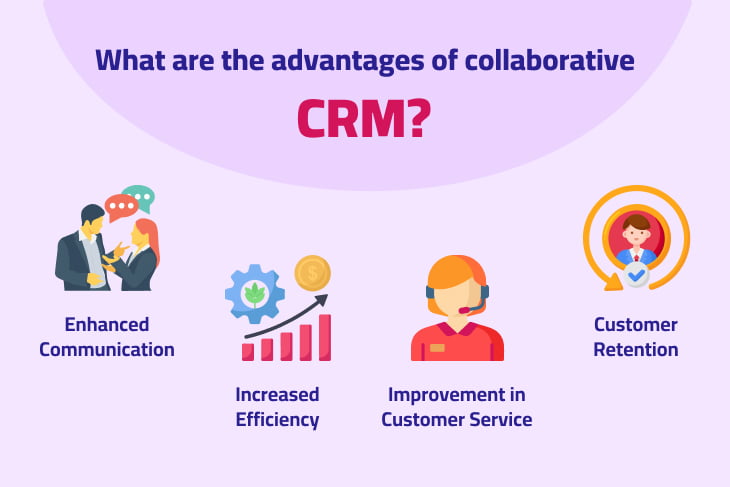What are the advantages of collaborative CRM?

Here are the key advantages of collaborative CRM:
Enhanced Communication
CRM fosters improved communication within an organization by providing a centralized platform where teams can share customer information, feedback, and insights. This ensures that everyone involved in customer interactions stays well-informed and aligned.
Increased Efficiency
Streamlined communication and centralized data contribute to increased efficiency. Teams can collaborate seamlessly, reducing duplication of efforts and ensuring that everyone has access to the latest customer information. This efficiency gives quicker response times and improved service delivery.
Improvement in Customer Service
With a shared knowledge base and real-time information updates, customer service teams can address inquiries more promptly and accurately. This leads to enhanced customer satisfaction, as issues are resolved efficiently, and customers feel that their needs are understood.
Customer Retention
Loyalty to the brand is the reason leading brands in many sectors prosper. To maintain client satisfaction and foster loyalty, an adjustment in strategy and paying attention to what each individual requires is important. Furthermore, prompt replies, automated follow-ups, and quick issue resolution improve the customer experience. Data-driven insights from the CRM system help to find chances for retention through cross-selling and upselling and to consistently fulfill changing customer expectations.
What to look for while choosing a collaborative CRM?
Centralized database
A consolidated customer information hub is provided by the appropriate CRM. Establishing a centralized repository for customer data guarantees that all members of the team have access to the most recent information and improves accuracy and consistency in client interactions.
Tools for communication
Efficient CRM software facilitates seamless teamwork by integrating communication channels including chat, email, and message. It makes it possible for you and your team to share information and communicate effectively in real-time. Not a CRM but, Alian Hub – a comprehensive project management app that helps streamline project management and communication channels. Thus, businesses can manage their projects and can solve issues related to projects in real time by communicating.
Management of tasks and activities
CRM software should help you or your project manager by providing tools for assigning, monitoring, and controlling activities related to client interactions. It should facilitate cooperative project work, guaranteeing that all parties involved are in line with the organization’s objectives.
Automation of workflows
Mundane tasks are automated by a competent collaborative CRM, which streamlines workflows and CRM procedures. Its automation offers a uniform, effective method of handling client contacts across all divisions within your organization and drastically reduces human labor.
Access control based on roles
Make sure team members have access to information about their responsibilities by looking for role-based access in your CRM application. An excellent tool encourages teamwork between various groups while preserving information security.
Capabilities for integration
Robust CRM software facilitates the integration of various corporate applications, such as support systems, sales tools, and marketing automation. By avoiding data silos and improving integration efficiency all around, this guarantees a seamless information flow within your team.
Reporting and analytics
For the program to provide insights into customer interactions, team performance, and company trends, it requires strong data analytics and reporting features. This data-driven strategy aids in making wise decisions and continually enhancing corporate operations.
Mobility
Team members should be able to keep in touch and work together while on the go with the software’s mobile access to CRM. This increases work process flexibility and reactivity.
Interface that is easy to use
The user interface of good CRM software is simple to use and intuitive. Without requiring in-depth training, your team finds it easy to use the product and encourages its adoption.
Conclusion
In a nutshell, there are several advantages of implementing collaborative CRM that go beyond those of typical CRM systems. Building better, more meaningful relationships with consumers is made possible for businesses by the capacity to share customer insights, simplify communication, and dismantle organizational silos. CRM improves customer satisfaction by promoting cooperation and communication throughout divisions within a company and helps businesses succeed.

